When New Embraces Old: Part 1, the Journey
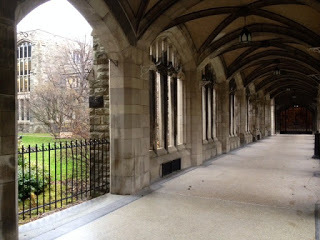 Breezeway of Knox CollegeWhen I first came to the University of Toronto to teach, I felt an abiding sense of “home” braced with the thrill of adventure. It was like “falling in love.” Really.
Breezeway of Knox CollegeWhen I first came to the University of Toronto to teach, I felt an abiding sense of “home” braced with the thrill of adventure. It was like “falling in love.” Really.To fall in love is like coming home, after all. And what is “home” but a tapestry of splendid memories whose textures weave us into who we presently are. It’s been three years since I came to UofT and I still feel that glowing thrill every time I walk through campus. Whether it’s past a century-old stone building, beneath a canopied archway of chestnuts, into a well-treed enclave, or through a high-ceilinged glass building; I am both home and on an adventure.
UofT is a place of learning—erudite, splendid, yet humble—beautifully epitomizing “new embracing old”. When new embraces old, we get magic. Wizard-magic. Harry Potter kind of magic. The kind of magic that only someone who is open, faithful, and confident can wield. This is ancient magic. The magic that lurks like Reznikoff’s ghost in the ancient halls of University College, or the magic currently wielded at 1 Spadina. A magic borne of wisdom, lore, and story.
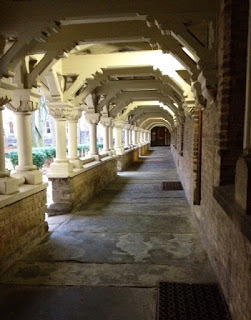 Courtyard behind University College
Courtyard behind University CollegeAll good stories understand and appreciate their origins. Good story builds on tradition toward something new and evolutionary. To journey forward, one must acknowledge the past. Ultimately, as Joseph Campbell said, that journey is a journey “home”.
UofT was founded 175 years ago as King’s College at the head of King’s circle. It was the first institution of higher learning in the colony of what was then Upper Canada. King’s College became the University of Toronto in 1849, and has steadily grown to include two more campuses (one in Scarborough and another in Mississauga), 9,000 faculty and staff and more than 60,000 graduate and undergraduate students. UofT has spawned major research achievements such as the discovery of insulin, the creation of the first electronic heart pacemaker, the single lung transplant and the discovery of the gene responsible for the most severe form of Alzheimer's disease. Recent advances include the discovery of the gene responsible for cystic fibrosis, cloning of the T-cell gene, and the world's first nerve transplant. During the research for my book Water Is… I continually ran across major achievements by UofT researchers in water and water-related science: from quantum entanglement in photosynthesis to billion-year water found in deep Canadian mine shafts. They are, of course, referred to in my book.
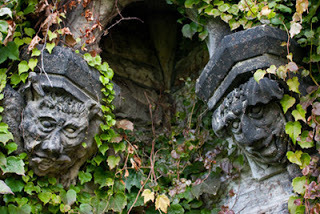 Diabolos and Reznikoff of University CollegeThe St. George campus of UofT lies embedded in the city of Toronto, steps away from the upscale shopping district of Yonge and Bloor and not much farther from the bustle of the financial district on King and Bay. It’s a bracing walk to Union Station, where every moving vehicle ends up at some time. UofT sprawls like an amoeba of neutrinos through the parliament buildings of University Avenue, making subtle changes here and there. Recreating the fabric of the cityscape in muonic subtleties.
Diabolos and Reznikoff of University CollegeThe St. George campus of UofT lies embedded in the city of Toronto, steps away from the upscale shopping district of Yonge and Bloor and not much farther from the bustle of the financial district on King and Bay. It’s a bracing walk to Union Station, where every moving vehicle ends up at some time. UofT sprawls like an amoeba of neutrinos through the parliament buildings of University Avenue, making subtle changes here and there. Recreating the fabric of the cityscape in muonic subtleties.This isn’t a typical century-old university campus, isolated from its city surroundings by an enclave of heritage buildings within an ornate campus of landscaped gardens and paths. UofT certainly has some of that. But the UofT downtown campus also sprawls dozens of blocks in all directions; embedding itself in the city with a blend of century-old buildings and avant-garde modern chic. It’s not so much re-inventing itself at every turn as morphing and co-evolving with the city. Old and new fold into one another, resembling symmetrical folds of metamorphic rock along a fault line. Like the entangled embrace of a Henry Moore sculpture.
I went on walkabout recently, after the last snows receded and gave way to the warm and restless winds of spring. The day blustered as I pulled up the collar of my spring coat and headed south from the St. George subway station. The sun beamed with the promise of hot summer days as the churlish wind stirred up leaves and debris into mini tornadoes. Winter’s detritus tracked a dizzy path, like whirling dervishes in tune with a seasonal dance.
I took my usual route south on St. George, toward Galbraith and Bahen buildings, where I teach, and soon found several examples of “new meets old”.
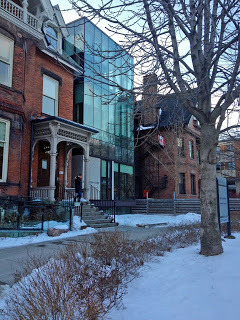 Max Gluskin HouseMax Gluskin House: UofT’s economics department recently expanded its home by connecting the department’s original Victorian and Georgian Revival buildings with a glass-enclosed hallway and a modern three-story addition called Max Gluskin House. The expansion unifies three heritage buildings with a contemporary glass building that creates an open connection. Its rust-coloured Corten steel harmonizes with the historic brick and, integrated with landscape features, provide an improved street presence.
Max Gluskin HouseMax Gluskin House: UofT’s economics department recently expanded its home by connecting the department’s original Victorian and Georgian Revival buildings with a glass-enclosed hallway and a modern three-story addition called Max Gluskin House. The expansion unifies three heritage buildings with a contemporary glass building that creates an open connection. Its rust-coloured Corten steel harmonizes with the historic brick and, integrated with landscape features, provide an improved street presence. Max Gluskin House includes a large undergraduate common room that faces into a courtyard, offices and research space for graduate students and faculty, rooms for TAs to meet with students, and expanded computer facilities. The project beautifully preserves and restores the beauty of the formal portions of the Victorian house, built in 1889 for William Crowther, and major portions of the Georgian building, completed in 1961. Ira Gluskin, who graduated from UofT’s commerce and finance program in 1964, provided the lead gift for the renovation. The facility is named in honour of his father, Max, who graduated from the same program in 1936.The renovation won second place in the commercial and institutional category of Toronto’s 2009 PUG Awards, the people’s choice awards in architecture.
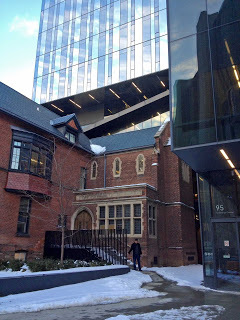 John Downey House embraced by RotmanRotman School of Management & John Downey House: When the Rotman School of Management needed to accommodate an ever-growing programming, student body, and faculty, it expanded 10-stories up right around John Downey House. Built in 1889, John Downey House typifies the Richardsonian Romanesque and Queen Anne Revival styles; called the Annex Style, it’s a blend of American and British architectural influences often associated with the wealthy.
John Downey House embraced by RotmanRotman School of Management & John Downey House: When the Rotman School of Management needed to accommodate an ever-growing programming, student body, and faculty, it expanded 10-stories up right around John Downey House. Built in 1889, John Downey House typifies the Richardsonian Romanesque and Queen Anne Revival styles; called the Annex Style, it’s a blend of American and British architectural influences often associated with the wealthy. The building emphasizes elaborate masonry and incorporates a prominent gable, woodwork and dormers. The Canadian School for Missions enlarged the building in 1929 with a two-storey addition in the Collegiate Gothic style. With the lofty backdrop of the Rotman Centre looming like a sentinel behind it, John Downey House sits like a russet island nested comfortably in a modern sea of cerulean glass. The centre itself, which I entered through an unassuming glass door, opens Tardis-like into an expansive open atrium with comfortable lounge and fireplace, study areas and stairways snaking up into ever higher levels
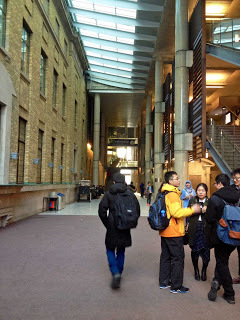 Atrium of Bahen with Koffler outer wallBahen & Koffler Buildings: The Bahen Centre for Information Technology was designed and built in 2002 to facilitate cross-disciplinary teaching and research for UofT’s Faculty of Arts and Science and the Faculty of Engineering. Named after John Bahen, president of the Peter Kiewit and Sons building company, it was based on the concept of a high-tech loft space, wrapping to the south and west around the 1909 Koffler Student Centre and to the north around 1878 Chadwick House.
Atrium of Bahen with Koffler outer wallBahen & Koffler Buildings: The Bahen Centre for Information Technology was designed and built in 2002 to facilitate cross-disciplinary teaching and research for UofT’s Faculty of Arts and Science and the Faculty of Engineering. Named after John Bahen, president of the Peter Kiewit and Sons building company, it was based on the concept of a high-tech loft space, wrapping to the south and west around the 1909 Koffler Student Centre and to the north around 1878 Chadwick House. The vaulting skylit arcade uses the Koffler Centre’s older outer wall as its south wall to provide pedestrian connections through the building; at its centre, a circular stair surrounds a glass tower of shared meeting rooms for eight levels.
Bahen’s north wing embraces Chadwick House, a
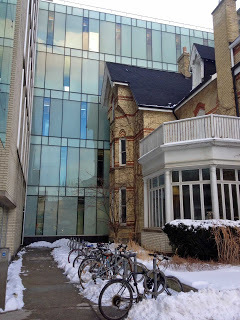 Chadwick House meets BahenVictorian house in a small courtyard opening off the street. The translucent glass of Bahen’s pavilion forms a contrasting backdrop to the connected Victorian building—with one of the best displays of dichromatic brickwork. The January 2003 issue of Canadian Architect magazine dubbed the Bahen Centre as "a complex interweaving of urbanity, public space and sustainability." It won the Ontario Association of Architects Award and City of Toronto Architecture and Urban Design Award, both in 2003. It also won a Bronze in the Environmental Category of the National Post Design Exchange Award.
Chadwick House meets BahenVictorian house in a small courtyard opening off the street. The translucent glass of Bahen’s pavilion forms a contrasting backdrop to the connected Victorian building—with one of the best displays of dichromatic brickwork. The January 2003 issue of Canadian Architect magazine dubbed the Bahen Centre as "a complex interweaving of urbanity, public space and sustainability." It won the Ontario Association of Architects Award and City of Toronto Architecture and Urban Design Award, both in 2003. It also won a Bronze in the Environmental Category of the National Post Design Exchange Award.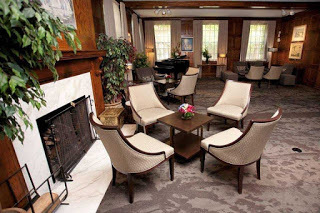 Faculty Club loungeUofT Faculty Club: Every journey requires repast—a place to relax, eat and drink—and my feet naturally directed me to one of my new favourite haunts: the UofT Faculty Club. Located close to the hub of the campus, on Wilcox Street just east of Spadina, the club is open to members who include faculty, staff, graduate alumni and their guests. I entered the 1896 heritage building, built in a Georgian Revival-style, and passed the elegant first floor lounge to the pub below. The pub welcomed me with excellent food, drink and a relaxing ambience. Bathed in rich tones of wood and comfortable chairs and warmed by a cozy fireplace, it reminded me of a Dorset pub I’d visited years ago; full of colourful characters and a well-stocked bar. I felt both at home and like a traveler. Like I’d walked into history with modern comfort. I ordered the beet salad from my friendly waitress; it provided a refreshing and attractive light meal for a mid-day traveller.
Faculty Club loungeUofT Faculty Club: Every journey requires repast—a place to relax, eat and drink—and my feet naturally directed me to one of my new favourite haunts: the UofT Faculty Club. Located close to the hub of the campus, on Wilcox Street just east of Spadina, the club is open to members who include faculty, staff, graduate alumni and their guests. I entered the 1896 heritage building, built in a Georgian Revival-style, and passed the elegant first floor lounge to the pub below. The pub welcomed me with excellent food, drink and a relaxing ambience. Bathed in rich tones of wood and comfortable chairs and warmed by a cozy fireplace, it reminded me of a Dorset pub I’d visited years ago; full of colourful characters and a well-stocked bar. I felt both at home and like a traveler. Like I’d walked into history with modern comfort. I ordered the beet salad from my friendly waitress; it provided a refreshing and attractive light meal for a mid-day traveller. What better place to end my journey of “new embracing old” than in a place where “old embraces new.”
More in Part 2.
Published on April 04, 2016 20:55
No comments have been added yet.



